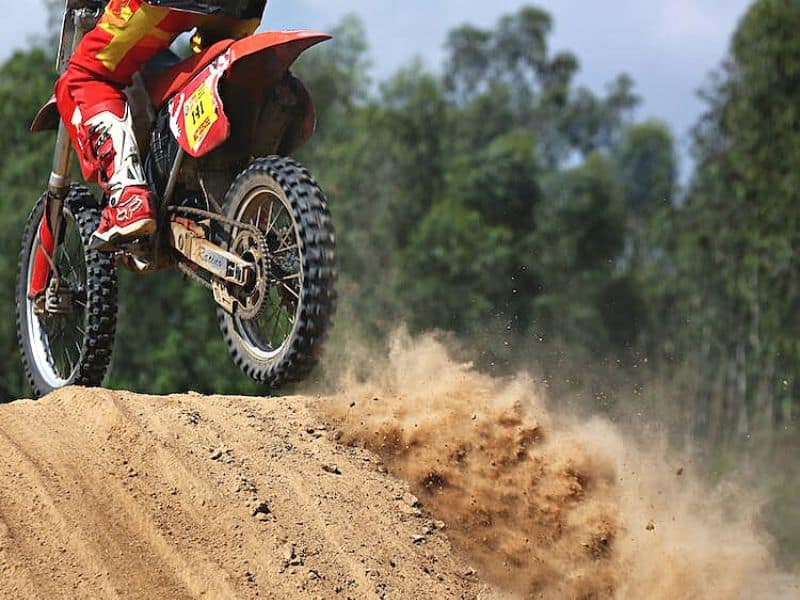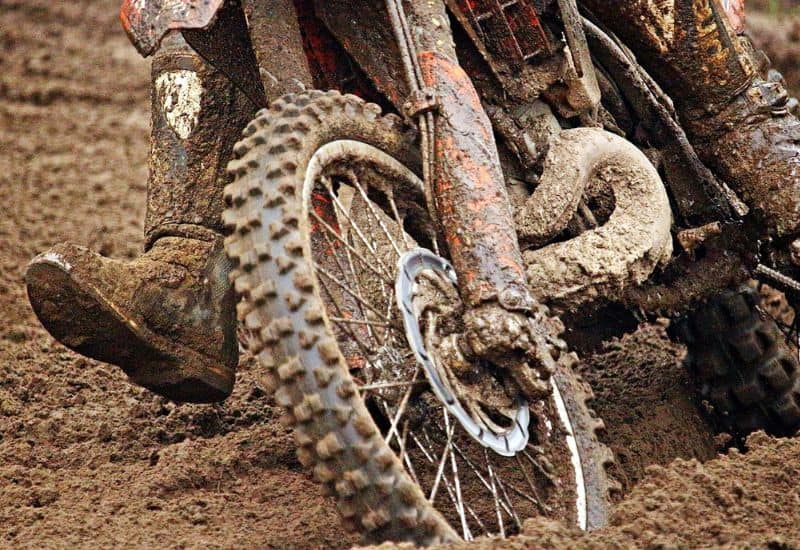While tubeless dirt bike tires do exist for hardcore or competition-level riding, tubed tires are the common go-to for everyday trail riding.
For casual off-road fun, tried and true tubes still deliver economical and reliable performance, which is why most dirt bike tires today still have tubes inside them.
There’s more you need to know about dirt bike tires and their inner workings though, than just whether they have tubes.
So if you’re new to dirt biking, keep reading, as there’s a range of factors you need to consider before choosing tubed or tubeless dirt bike tires.
Including the type of terrain you’re tackling, your preferred tire pressure, and the level of riding you plan on doing.
Key Takeaways
- Tubed tires are the standard for most riders due to their cost-effectiveness, durability, and flexibility in tire pressure.
- Tubeless tires offer benefits for more extreme riding conditions but require a higher initial investment and more complex maintenance.
- Popular tubeless options include mousse inserts and tubliss systems.
- When selecting dirt bike tire tubes, it’s important to consider the material, size, and thickness.
Why Most Dirt Bikes Tires Have Tubes
While tubeless systems are gaining popularity in certain segments of off-road motorcycling due to their enhanced durability and ability to run at lower pressures, tubed tires remain dominant for a variety of reasons.
Here are the key reasons why most dirt bikes continue to use inner tube tires rather than tubeless alternatives:
- Durability and Puncture Repair: Tubes provide a good amount of durability for the average rider. If a tubed tire gets punctured, you can generally replace or repair the tube on the trail easily.
- Cost-Effectiveness: Tubed tires are less expensive than their tubeless counterparts. This makes them a more economical choice for riders.
- Ease of Installation: Putting in a new tube is often simpler and faster than setting up a tubeless tire.
- Tire Pressure Flexibility: With tubed tires, riders can run a wider range of tire pressures. This is especially important for adjusting the grip and performance of the bike to different terrains and conditions.
- Compatibility and Availability: Many dirt bikes come standard with tubed tires, and there is a wide variety of tubes available, making it easier to find replacements or upgrades.
- Ride Familiarity – Most dirt bikers learned on inner tube tires so they prefer sticking with what they know and trust.
Tubeless Alternatives for Dirt Bike Tires
While the vast majority of dirt bikes have tubed tires, tubeless alternatives do exist, which can make sense for some riders.
Especially for more extreme off-road dirt bike riders, tubeless technology virtually eliminates flats and pinch flats and provides improved performance in severe conditions.
The two main alternatives to traditional inner tube tires are mousse inserts and tubeless tire systems.
Mousse Inserts
Mousse inserts are made from lightweight, flexible polyurethane foam that fills the interior volume of the tire.
Mousse inserts, also known as “bib mousse”, are an alternative to both traditional tubes and tubeless systems used in dirt bike tires.
These inserts are designed to mimic the feel of a pneumatic tire, typically around 12-15 psi, which is a common pressure for off-road riding.
Advantages of Using Mousse Inserts
- Flat Prevention: Mousse inserts, made from foam, prevent punctures or pinch flats typically associated with air-filled tubes, making them ideal for racing or riding in environments where tire damage is common.
- Consistent Feel: Mousse inserts provide a consistent feel because they do not change pressure like air-filled tires do. Air pressure can vary with altitude, temperature, and during a ride, as the tires heat up.
- Durability in Rough Terrain: They are extremely durable in rough terrain where sharp objects might slice a tire or puncture a tube. This is why they’re favored in professional enduro and rally competitions where the terrain can be unpredictable and unforgiving.
Disadvantages of Using Mousse Inserts
- Installation Difficulty: They can be more difficult to install than traditional tubes, requiring special tools and techniques.
- Cost: Mousse inserts are generally more expensive than tubes and may not last as long as a good quality tube or tubeless setup because they can break down over time.
- Specific Feel: Some riders may not like the feel of mousse inserts as they do not allow for pressure adjustments to fine-tune the ride characteristics for different conditions or personal preferences.
- Heat Build-up: In long-distance or high-speed riding, mousse inserts can build up heat which may lead to degradation of the material more quickly than a traditional tire.
For riders who compete or those who frequently ride in conditions where the risk of punctures is high, mousse inserts can be a game-changer.
However, for the average rider, the cost and disadvantages of mousse inserts are usually not worth it.
Tubeless System
The tubliss tire system takes mousse technology further by using a flexible inner liner attached to the rim which provides the durability of a mousse insert and the pressure flexibility of a tube.
Tubeless tire systems are an innovative solution that caters to riders looking for the puncture resistance of a mousse insert but with the flexibility of air pressure adjustment like a traditional tube.
The tubeless system essentially replaces the conventional inner tube with a high-pressure, smaller inner tube locked to the rim.
Advantages of a Tubeless System
- Pressure Adjustment: Unlike mousse inserts, the tubeless system allows riders to adjust the air pressure in the tire for different riding conditions, preferences, and terrain types. This means you can run very low pressures for increased traction without worrying about pinch flats.
- Durability: The high-pressure inner tube of a tubeless system is much less likely to suffer a puncture than a traditional tube, which increases its durability, much like a mousse insert.
- Weight Savings: Tubeless systems can be lighter than traditional heavy-duty tubes and even some mousse inserts, contributing to reduced rotating mass and improved handling.
Disadvantages of a Tubeless System
- Complexity and Installation: The tubeless system is more complex to install than a traditional tube. It requires careful installation to ensure the high-pressure inner tube is seated correctly to maintain the bead lock.
- Maintenance: The system needs to be checked regularly to ensure that the high-pressure inner tube maintains its pressure to keep the bead lock secure.
- Initial Cost: The upfront cost of a tubeless system is higher than traditional tubes, but for many riders, the benefits outweigh this initial investment.
The tubeless system is a great option for those who want the ability to adjust tire pressure for optimal performance and still have considerable protection against flats and pinch flats.
It’s a hybrid approach that takes the benefits from both the tubed and mousse worlds, making it a popular choice for serious off-road and enduro riders.
Getting the Right Tubes for Your Dirt Bike Tires
When choosing the best tubes for your dirt bike tires there are three main considerations you need to keep in mind, including the tube material, the tube size, and the tube thickness.
All three of these factors can significantly influence the performance and durability of your dirt bike tire.
Because of this, it’s important to understand how each one contributes to your ride.
Tube Material
The most common materials for dirt bike tubes are butyl rubber and natural rubber.
Butyl rubber tubes are man-made from petroleum, and their biggest advantage is cost, as Butyl tubes cost less than natural rubber ones.
Natural rubber on the other hand is made from the sap of a rubber tree, and while they are more expensive they are also more pliable and flexible.
Allowing them to conform better to the tire, which reduces the likelihood of pinch flats.
Tube Size
Dirt bike tires come in all different sizes and configurations.
Because of this, it’s important to match the tube size to your tire size for proper fit.
For example, if you have a 19-inch rear rim and a 120 tire, you’re going to want to run a 19-inch by 120 tube.
If you run a smaller tube inside your tire, you’re going to have to over-inflate the tube, which can weaken it and make it more prone to pinch flats.
On the flip side, if you run a larger tube than your tire size, you’re going to have excess material, which also makes the tube more susceptible to pinch flats.
Tube Thickness
Dirt bike tubes have three thicknesses to choose from, including standard, heavy-duty, and ultra-heavy-duty.
Standard tubes are going to be between 1 and 2 millimeters thick, heavy-duty tubes are going to be between 2 and 3 millimeters thick, and ultra-heavy-duty tubes are going to be 4 millimeters thick.
Standard tubes are best suited for general or casual riding. They’re the least expensive option but they’re also thinner.
Because of this, they’re more prone to puncture and pinch flats, so if you’re using a standard tube don’t run too low of a PSI.
Heavy-duty dirt bike tubes are great for those looking for more pinch flat protection or who want to run a lower tire pressure.
As a trade-off though, they are a little more expensive and heavier than standard tubes.
For the ultimate in puncture resistance and pinch flat protection, the best option is ultra-heavy-duty tubes.
Best suited for extreme riders or enduro riders, these tubes offer the most protection but they are also the most expensive and the heaviest.
Conclusion – Tubed or Tubeless?

Whether you choose tubed or tubeless tires for your dirt bike comes down to personal preference, riding style, and the conditions you’ll be tackling on the trails.
For most riders, dirt bike tires with standard tubes are the best option, as they offer a lightweight and cost-effective solution that’s easy to replace and repair.
On the flip side, tubeless options like mousse inserts and tubeless tire systems can be a better choice for extreme riders who want the greatest amount of durability and flexibility.
If you do end up going this route though, be prepared for a higher upfront investment and more complex maintenance.
In the end, remember that the right choice between tubed or tubeless is the one that best fits your needs and riding style.

